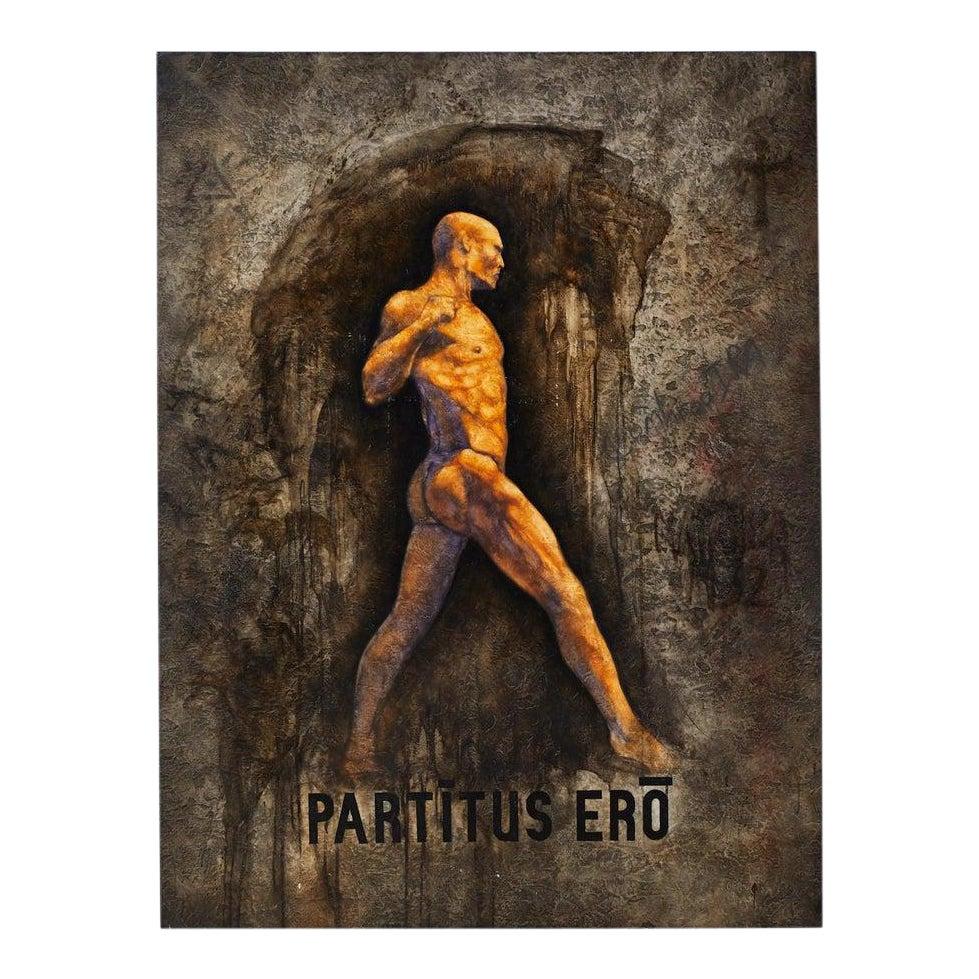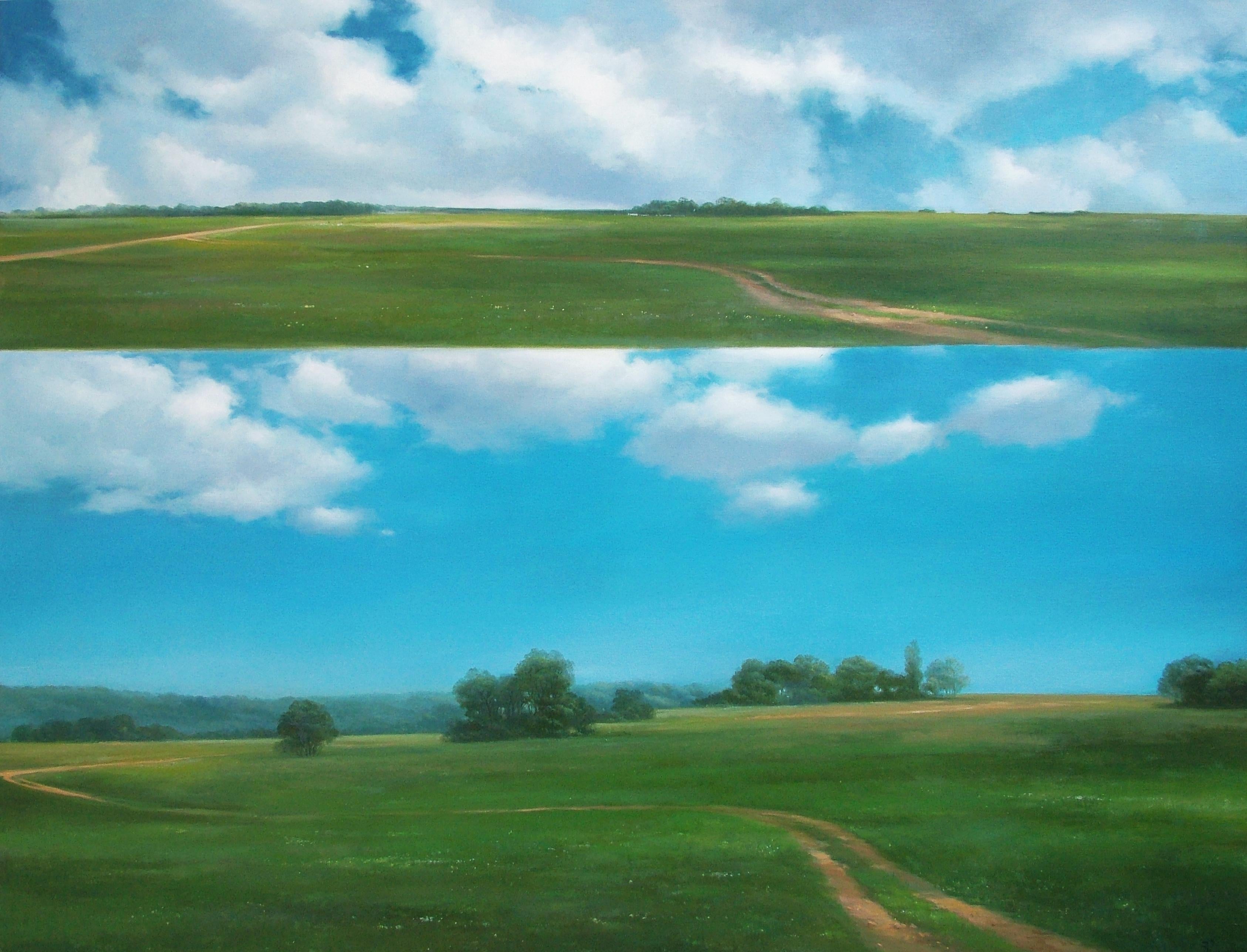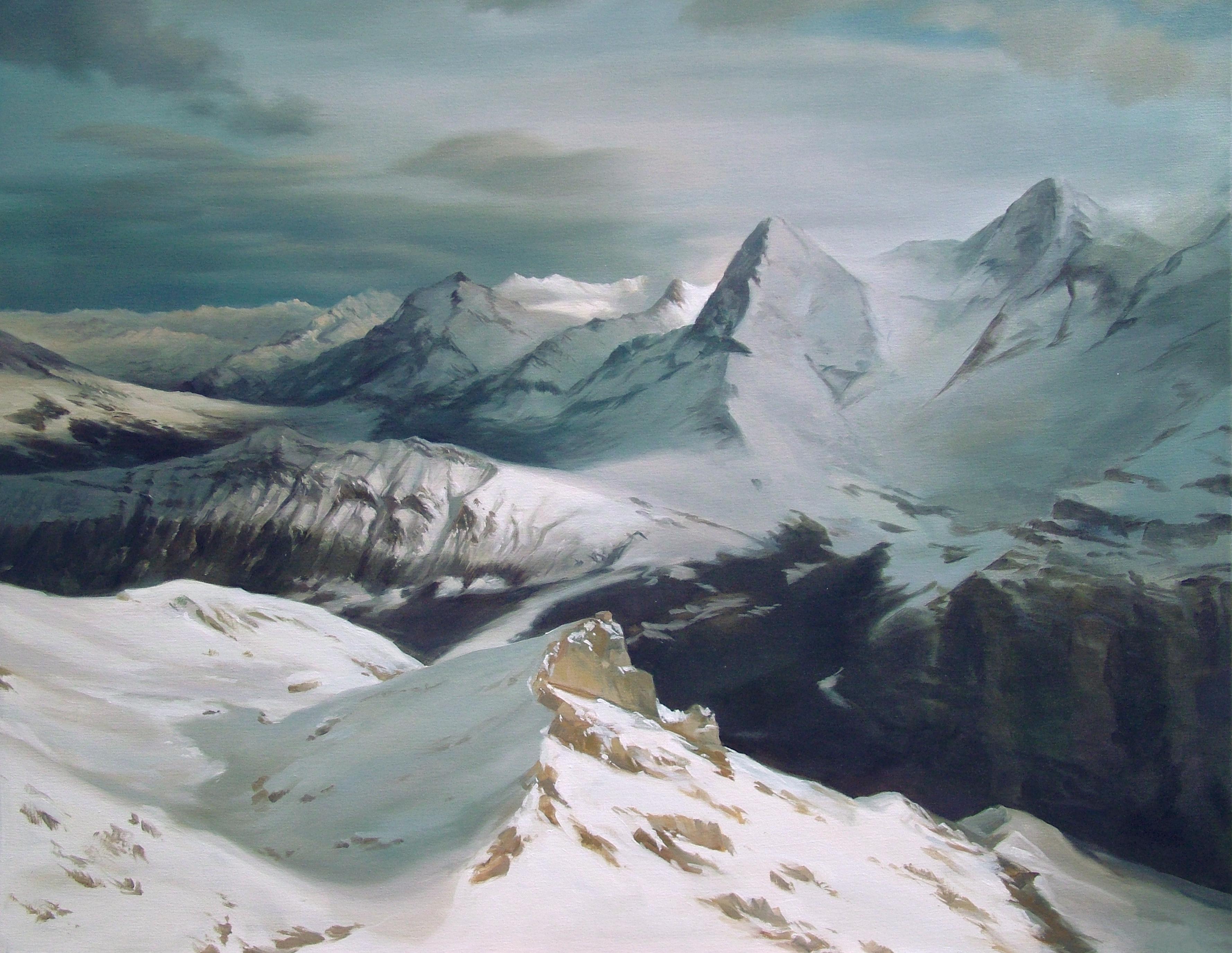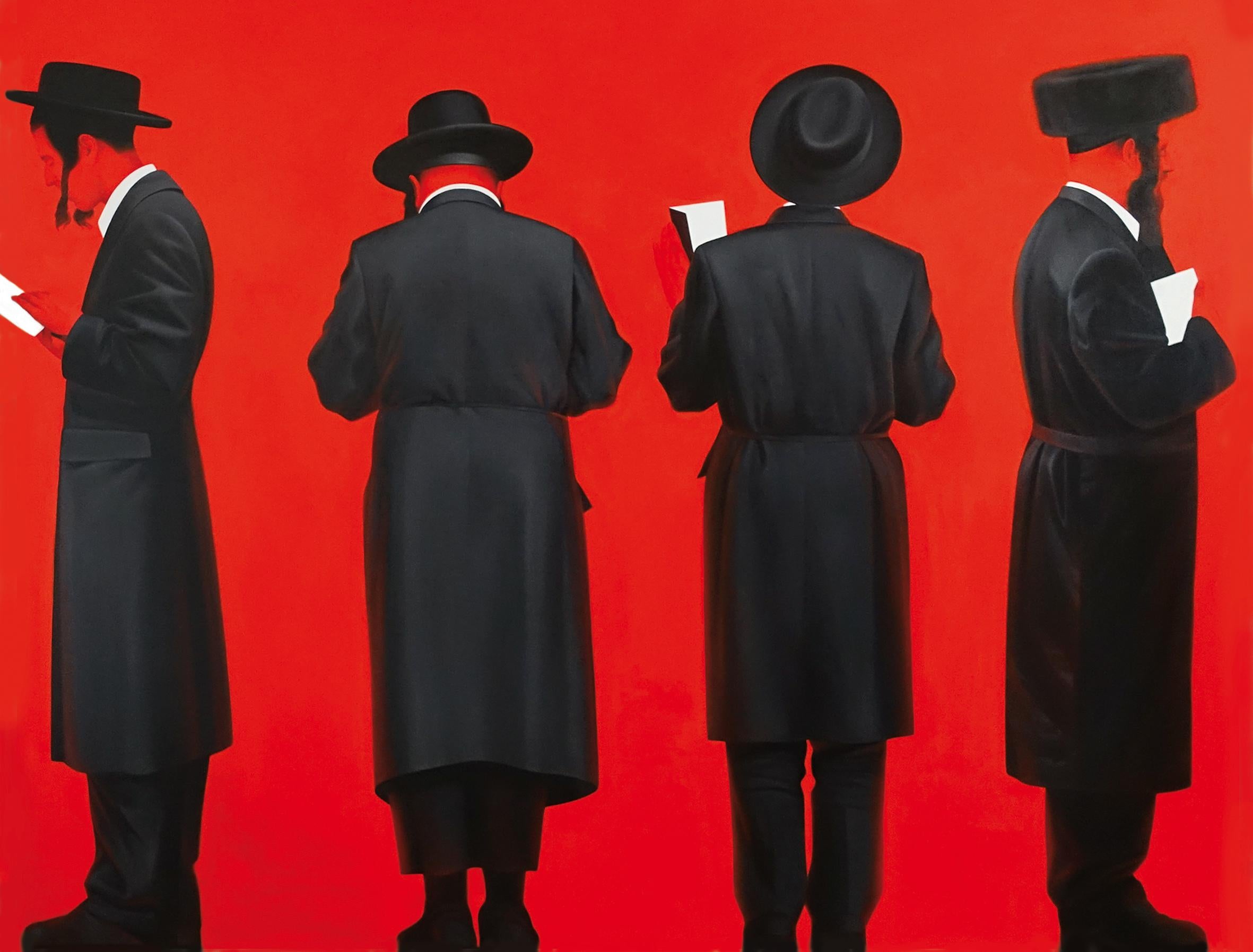Items Similar to Atlantis, Large Surrealist Oil Painting. Viennese Fantastic Realism
Want more images or videos?
Request additional images or videos from the seller
1 of 13
Peter KolinAtlantis, Large Surrealist Oil Painting. Viennese Fantastic Realism1980
1980
About the Item
Atlantis, A large spectacular nautical, marine magic fantasy. (without the frame it is 32X39 inches)
The roots for Peter Kolin’s fascinating world of Surrealist Fantasy, Magic Realist images can be traced back to the art of Mannerism, a brief period - approximately 1520 to 1610 - between the Renaissance and Age of the Baroque. In Mannerist paintings composition had no focal point and space could be ambiguous. Surreal figures could be characterized by athletic bending and twisting with distortions, exaggerations, elastic elongation of the limbs, bizarre or graceful posturing and the rendering of the heads as uniformly small and oval. (reminds me very much of some of the compositions of Salvador Dali) The composition was full of clashing symbolist colors very unlike the balanced, natural and often dramatic colors of the High Renaissance. Mannerist works presented instability and restlessness and also showed a fondness for allegories with lascivious undertones. Kolin, an exceptionally gifted painter within this tradition, creates gorgeous and mysterious fantasies of Surrealism with each work opening a new and more exciting fantastic world. His narrative world of images and symbols is presented in his own metaphorical language but with a visual accuracy solidly rooted in technical perfection. Today Kolin is a widely acclaimed artist of the Vienna School of Fantastic Realism. (Together with, Arik Erich Brauer, Ernst Fuchs, Rudolf Hausner, Fritz Janschka, Wolfgang Hutter and Anton Lehmden.)
- Creator:Peter Kolin (1942, Austrian)
- Creation Year:1980
- Dimensions:Height: 38 in (96.52 cm)Width: 45 in (114.3 cm)
- Medium:
- Movement & Style:
- Period:
- Condition:
- Gallery Location:Surfside, FL
- Reference Number:1stDibs: LU38210796052
About the Seller
4.9
Platinum Seller
These expertly vetted sellers are 1stDibs' most experienced sellers and are rated highest by our customers.
Established in 1995
1stDibs seller since 2014
1,547 sales on 1stDibs
Typical response time: 1 hour
- ShippingRetrieving quote...Ships From: Surfside, FL
- Return PolicyA return for this item may be initiated within 3 days of delivery.
More From This SellerView All
- Untitled, Nude Surreal Figures Together Slovenian French Oil PaintingBy Heinrich Maryan FramaLocated in Surfside, FLGenre: Surrealism Subject: Abstract Medium: Oil Surface: Canvas Country: France In this surreal composition by Heinrich M. Frama the artist clumps a group of figures towards the mid...Category
20th Century Surrealist Figurative Paintings
MaterialsCanvas, Oil
- Large Russian Israeli Fantastic Realism Surrealist Oil Painting Girl with SwanBy Rina SutzkeverLocated in Surfside, FLRina Sutzkever Calderon (Russian/Israeli, b. 1945), Fly Away Oil on canvas, signed at lower left, presented in a gilt frame with linen liner. Frame dim...Category
20th Century Surrealist Animal Paintings
MaterialsCanvas, Oil
- Large Italian Modernist Surrealist Lady Mod Oil Painting "La Ragazza Ungherese"By Lazzaro DonatiLocated in Surfside, FLLazzaro Donati (Italian, 1926-1977), Framed oil painting "La Ragazza Ungherese" The Hungarian Girl. Dated 1961. Framed: 36.25 x 28.5 inches. In good condition. Lazzaro Donati was born in Florence and attended the Academy of Fine Arts. He began to paint in 1953, and in 1955 held his first exhibition at the Indiano Gallery in Florence. Within three years eleven exhibitions followed in Italy, and as his reputation grew he was invited to give major exhibitions in London, Paris, New York, Chicago, Rio de Janeiro and Montevideo. He is considered one of the foremost contemporary Italian painters and his paintings hang in museums and private collections throughout the Americas, Europe and Asia. His work i faucist recalling the works of the french Raoul Dufy, Dunoyer de Segonzac, Francois Gall and jean Jansem. Donati lived and worked at 24 Piazza Donatello in Florence, the square where generations of artists have created works worthy of the great Florentine tradition. As you entered the narrow hallway to his studio, a gilded life-size Venetian angel beckoned you to his door. Once inside, the present faded away and you found yourself in an atelier where early masters might have worked during the Renaissance. Within, luxurious Persian rugs set off the innumerable objects d’art and antique furnishings. Light poured in through the sloping glass wall on the north side. A dramatic stairway led to an overhanging balcony which served as a private gallery where the artist hung some of his favorite early works. To the left of the entrance was a smaller studio where Donati sculpted, with a window overlooking the famous old English cemetery where tourists laid flowers on the grave of Elizabeth Barrett Browning. In the main studio itself, where Donati received his clients in an atmosphere as polished as an office of a top executive, one hardly realized that it was here that the artist actually painted. His easel was covered with Persian blue velvet, the painting on the easel was already framed, his chair was upholstered in red velvet and on his palette the colors were arranged with the precision of a Byzantine mosaic. In a corner stand were his latest works, framed and ready to be sent off to his next exhibition in Europe or America. He spoke fluent French and English as well as some Spanish and German. “After all”, he said, “you've got to know how to sell...Category
1960s Surrealist Figurative Paintings
MaterialsCanvas, Oil
- French Surrealist Trompe L'oeil Apples OIl PaintingBy Lucien MathelinLocated in Surfside, FLsize uncludes frame. Lucien Mathelin, born in 1905 in Binche, A province of Hainaut, in Wallonia, Belgium, and died in 1981 in Paris. French painter. His work was influenced by surrealism andtinged with irony. Lucien Mathelin was born in a family of artists and has benefited from artistic training since childhood. He made his first oil on canvas at the age of 15 in 1920. In 1924, he exhibited at the Salon d'Automne which he became a member. He did not study plastic arts, but traveled to Morocco (1925-1926) and Greece (1933-1934), where he enriched his palette. In 1937, Mathelin worked for a while for Raoul Dufy to realize the gigantic painting...Category
20th Century Surrealist Still-life Paintings
MaterialsCanvas, Oil
- French Surrealist Circus Scene, Children with Balloons Oil Painting J.P. SerrierBy Jean Pierre SerrierLocated in Surfside, FL14.5x10.5 framed, 9X5 without frame Jean Pierre Serrier (1934 – 1989) was a French painter known for surrealism and absurdist art. Jean-Pierre Serrier was born in Montparnasse, Paris and attended the Académie des Beaux-Arts in Paris. the son of Louis and Solange Serrier. His father fought in World War II and became a prisoner of war. In 1940, as a six-year-old, he and his mother fled Paris for Corrèze in southwest France. Childhood memories of close escapes from German bombardments would later influence his absurdist philosophy of life. Passionate about drawing, in 1951 he applied and was admitted to the École nationale supérieure des arts appliqués et des métiers d'art in Paris. He shared an attic apartment in the 16th arrondissement with fellow student Jean-Baptiste Valadié. For income, he decorated shop windows. A trip to Spain provided motifs for early works. His student work might be characterized as art naïf...Category
20th Century Surrealist Figurative Paintings
MaterialsCanvas, Oil
- French Mod Surrealist Commedia dell'arte Circus Scene Oil Painting J.P. SerrierBy Jean Pierre SerrierLocated in Surfside, FLJean Pierre Serrier (French, 1934-1989) Oil on canvas painting depicting four figures Hand signed lower right. Measures (frame) 26.5" x 30" wide, and (sight) 18.25." x 22.25" wide. Jean Pierre Serrier (1934 – 1989) was a French painter known for surrealism and absurdist art. Jean-Pierre Serrier was born in Montparnasse, Paris and attended the Académie des Beaux-Arts in Paris. the son of Louis and Solange Serrier. His father fought in World War II and became a prisoner of war. In 1940, as a six-year-old, he and his mother fled Paris for Corrèze in southwest France. Childhood memories of close escapes from German bombardments would later influence his absurdist philosophy of life. Passionate about drawing, in 1951 he applied and was admitted to the École nationale supérieure des arts appliqués et des métiers d'art in Paris. He shared an attic apartment in the 16th arrondissement with fellow student Jean-Baptiste Valadié. For income, he decorated shop windows. A trip to Spain provided motifs for early works. His student work might be characterized as art naïf (Naive art). While still a student, he sold a ceramic artwork to the poet and publisher Pierre Seghers, who would later commission drawings from him. He frequented jazz clubs in Saint-Germain des Près, and while listening to Sidney Bechet at the Vieux Colombier, he met his wife, Yvette.One of the last French Surrealist and follower of Nietzsche. His art conveyed the message to all of mankind that we are only human. The other Surrealist to center his art in philosophy was Rene Magritte whose paintings reflect his understanding of Sigmund Freud. He had his first exhibition in 1955, before being sent to Algeria to complete his military service. After graduating in 1955, he was drafted for military service, spent time in Germany and Morocco, and was sent to the front lines of the Algerian War. In 1959 he exhibited works at two Parisian galleries and at Juan-les-Pins on the Côte d'Azur. From 1961, he exhibited annually at the Salon des Artistes Français. In 1962, the City of Paris purchased his painting Un dimanche In 1961, Serrier made his first visit to the United States to exhibit at a New York gallery. In 1975 and 1979, he had successful exhibitions in New Orleans, and his work was included in art and news magazines, including Time and Newsweek. Beginning in the 1950s, his works included stylized portraits similar in some ways to the "big eyes" art of Margaret Keane, though it is uncertain that either artist influenced the other. Keane painted children, and so did Serrier, sometimes from life, but Serrier’s models are usually somewhat older, though uniformly slender and with androgynous features. A gallery owner introduced Serrier to American collectors Edgar Garbisch and his wife, Bernice Chrysler (daughter of Chrysler founder Walter P. Chrysler), who had a particular interest in naïve art; they commissioned a series of portraits from Serrier. At the same time, he met Reine Ausset in Paris, who in 1961 invited him to New York to take part in an exhibition at Galerie Norval on 57th Street. The show also included work by Moïse Kisling, and the exhibition program explicitly linked the two artists, saying that Serrier, who considered Moise Kisling "the Master," had found his own technique, but "the same vision joins the grand Kisling to the young Serrier: plenitude of shapes, sureness of palette, precision in outlines." In the 1960s he began painting slender, young, androgynous figures in groups, set in sparse landscapes with suggestions of the surreal and sometimes wearing costumes of the Commedia dell'arte. In some of these paintings the eyes of the figures are completely black, a motif that would continue in his later work. In 1965, he exhibited at Forest and Reed Gallery in London. Also in 1965, he discovered the small town of Martel, and with his old roommate Jean-Baptiste Valadié purchased a house that they opened as the gallery La Licorne (The Unicorn) in 1967. Responding to the political upheavals of May 1968 in France, and following the advice of Geneva gallery owner Roger Ferrero, Serrier's work became increasingly complex, idiosyncratic, and surreal. Imagery included the Tower of Babel, bodies suspended in space, and crowds of people all dressed alike, with identical features and entirely black eyes. Mannequins, playing cards, nudes, and levitating orbs also figured in the work. In a nod to Magritte, his men sometimes wear bowler hats. Another influence may have been the works of the Franco-Belgian surrealist Gaston Bogaert (1918-2008). Serrier's first major exhibit of these works, in Geneva in 1971, was titled Le Réalisme Fantastique. (Magic Realism) In 1972, he was made a member of the Société du Salon d'Automne, under whose auspices he was invited by the Polish government to exhibit in Warsaw in 1973, as part of a cultural exchange across the Iron Curtain. In 1976, he served on the jury of the Salon d'Automne. In 1975, New Orleans gallery owner Kurt E. Schon brought his work to several cities in the United States. A copiously illustrated monograph in English, Surrealism and the Absurd: Jean Pierre Serrier, was published in 1977. Author Thomas M. Bayer wrote: Serrier's world is one where—to use Friedrich Nietzche's term—the "human herd animal" is being confronted with the overwhelming task of coping with the world, his solitude, and at times, his resignation in the face of its monstrous size and duration. It is a world where the characterless, "blind" man faces the institutions, rules and symbols that made him into the being he now is…But Serrier does not lose himself in this world he portrays. He never forgets the old French tradition, the "black" humor, à la Molière. This classical humor at times is more felt than seen, in a manner that can be terribly funny, because it is horrifying, laughable, poignant and always true. Serrier told a friend, "In each of my paintings there's a message of hope amid the crowd of stereotypical figures. It could be an escaping dirigible, or a nymphet who flees like a deer under the red and blue trees of paradise...Category
Mid-20th Century Surrealist Figurative Paintings
MaterialsOil, Canvas
You May Also Like
- Separation of Creation Oil PaintingBy John U. AbrahamsonLocated in Rio Vista, CADramatic oil on canvas surrealist painting by John Abrahamson (American 20th Century) depicting a nude male with the motto Partitus Ero or I wager in Latin. Abrahamson is known for h...Category
20th Century Surrealist Figurative Paintings
MaterialsOil, Canvas
- SPRING UP, Oil on CanvasLocated in Montreux, CHKaren Shahverdyan „Eleven“ 129 X 147cm, oil on canvasCategory
Early 2000s Surrealist Landscape Paintings
MaterialsCanvas, Oil
- MOUNTAINS, Oil on CanvasLocated in Montreux, CHKaren Shahverdyan „Mountains“ 80 X 100cm, oil on canvasCategory
Early 2000s Surrealist Landscape Paintings
MaterialsCanvas, Oil
- THE FIFTH ELEMENT II, Oil on CanvasLocated in Montreux, CHKaren Shahverdyan „The fifth element II“ 160 X 190cm, oil on canvasCategory
2010s Surrealist Figurative Paintings
MaterialsCanvas, Oil
- ELEVEN, Oil on CanvasLocated in Montreux, CHKaren Shahverdyan „Eleven“ 129 X 147cm, oil on canvasCategory
Early 2000s Surrealist Figurative Paintings
MaterialsCanvas, Oil
- TORERO, Oil on CanvasLocated in Montreux, CHKaren Shahverdyan „Torero“ 130 X 180cm, oil on canvasCategory
2010s Surrealist Figurative Paintings
MaterialsCanvas, Oil
Recently Viewed
View AllMore Ways To Browse
New Large Oil Painting
Oil Painting Realism
1980 Oil Paintings
Large Vintage Oil Painting Paintings
Very Large Oil Paintings
Very Large Oil Painting
Large Period Painting
Figurative Realism
Surrealist Oil Painting
Figurative Realism Paintings
Art Fantastic Frame
Large Oil Paintings With Blue
Surrealist Painting Canvas
High Renaissance
Framed Surrealist Painting
Space Fantasy
Small Retro Oil Paintings
Large Surrealist





